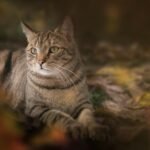Have you ever looked into your cat’s eyes and wondered if they really get you? Maybe during your saddest days, your feline friend curled up beside you, purring with a gentle insistence that seemed almost magical. Or perhaps your cat’s playful antics matched your own good mood, like a tiny, furry reflection of whatever was happening inside your heart. The truth about cats and emotional mirroring is both mysterious and surprisingly profound—delving into it will make you see your whiskered companion in a whole new light. Get ready for a journey through science, stories, and secrets that might just change the way you see your cat forever.
What Is Emotional Mirroring in Cats?

Emotional mirroring is a fascinating behavior where cats seem to reflect the emotions of their human companions. This isn’t just about copying actions—it’s about feeling what you feel and responding in ways that align with your mood. Imagine coming home after a tough day and your cat quietly joins you, almost as if sensing your sadness. Or picture your cat suddenly bursting into play when you’re laughing with friends. Emotional mirroring isn’t always obvious, but it’s there in the subtle ways cats adjust their behavior. It can feel almost supernatural, yet it’s a natural part of their social intelligence. Understanding this can make our bond with cats even stronger. It’s not just about affection—it’s about empathy.
The Science Behind Feline Empathy

Recent studies have begun shedding light on the mysterious world of feline empathy. Researchers have observed that cats can pick up on human emotional cues, such as tone of voice, facial expressions, and even body language. Unlike dogs, who are known for their overt emotional responses, cats tend to show their empathy in more understated ways. Scientists believe this is partly due to the cat’s evolutionary history as both predator and prey, making them cautious but observant. The amygdala, a part of the brain linked to emotion, is highly developed in cats. This means they are capable of processing and reacting to emotional information, even if they don’t always show it dramatically. It’s a reminder that cats are quietly in tune with us, even when we least expect it.
How Cats Sense Human Moods

Cats have an uncanny ability to sense human moods, sometimes more accurately than our human friends. This sensitivity is rooted in their acute senses—they can pick up changes in your scent, the pitch of your voice, and even your breathing patterns. If you’re anxious or stressed, your body releases different hormones, which your cat can detect. You might notice your cat keeping a watchful distance when you’re upset, or cuddling closer when you need comfort. It’s as if they have an invisible radar for feelings. Some cat owners swear their pets know when they’re about to cry, showing up just in time for a comforting nuzzle. Whether it’s science or magic, there’s no denying their special intuition.
Physical Behaviors That Reflect Your Emotions

Have you noticed your cat mirroring your movements or posture? If you’re lounging on the couch, your cat might curl up nearby in a similar pose. When you’re busy and energetic, your cat may zip around the house, chasing shadows or toys. Emotional mirroring often shows up as physical mimicry—sitting, stretching, or even yawning when you do. It’s like a secret handshake, only fluffier. These small acts create a sense of connection, making you feel understood in a way that words can’t express. Next time you catch your cat copying your actions, give them a little smile—they’re just trying to say, “I’m with you.”
Purring: Soothing More Than Just Themselves

Purring is one of the most mysterious and comforting sounds in the animal world. While it’s often associated with a cat’s contentment, research suggests cats also purr to comfort their humans. When you’re sad or sick, a cat’s purr can feel like a gentle lullaby, calming your nerves and easing your stress. The frequency of a cat’s purr has even been shown to promote healing, both physically and emotionally. Some people compare it to a mini massage for the soul. Cats may purr louder or more persistently when they sense you need comfort, making it a powerful form of emotional mirroring.
Why Cats Hide When You’re Upset

Not all emotional mirroring looks like comfort. Sometimes, when you’re angry or distressed, your cat might vanish under the bed or behind the curtains. This isn’t rejection—it’s a form of empathy. Cats are highly sensitive to negative energy and may retreat to protect themselves or avoid escalating the situation. Their withdrawal is a silent way of acknowledging your mood. It’s as if they’re saying, “I see you need space, so I’ll give it.” This behavior shows that emotional mirroring isn’t just about closeness—it’s also about respecting boundaries and emotional signals.
Playfulness and Positive Vibes

When you’re happy or excited, your cat often picks up on that energy. Playful moods are contagious, and cats are wonderful at joining in. You might find your cat darting around, chasing toys, or even “talking” more when the atmosphere is light and joyful. Their antics can lift your spirits even higher, creating a joyful feedback loop. This playful mirroring is one of the most delightful parts of living with a cat. It reminds us that happiness is meant to be shared, and sometimes all it takes is a bit of string or a ball of paper to double the fun.
Cats and Comfort During Illness

There’s something almost magical about a cat’s ability to comfort us when we’re not feeling well. Many people report that their cats become extra affectionate or attentive during times of illness or pain. Whether it’s curling up on your chest or gently tapping your hand, cats seem to know when you need a little extra love. Some experts believe they’re drawn to the warmth of a sick person’s body, but others argue it’s a deeper sense of empathy. Either way, their presence is a powerful source of comfort, offering silent support when words aren’t enough.
Mirroring Stress and Anxiety

It’s not all cuddles and comfort—sometimes, cats mirror our stress and anxiety, too. If you’re feeling tense, your cat might act out, become more vocal, or even seem agitated. This can create a feedback loop where your stress feeds theirs and vice versa. It’s a good reminder to check in with your own emotions; your cat may be picking up on things you haven’t even noticed about yourself. Creating a calm environment benefits both of you. Sometimes, taking a deep breath and relaxing is the best thing you can do for your cat, as well as yourself.
The Role of Routine in Emotional Mirroring

Cats are creatures of habit, and sticking to a routine helps them feel secure. If your daily life becomes chaotic, your cat may become unsettled, reflecting your stress back at you. On the flip side, a calm, predictable routine can help both you and your cat maintain emotional balance. Feeding, playtime, and cuddles at regular times each day create a rhythm that soothes both species. When a routine is disrupted—like moving house or changing jobs—your cat’s behavior may change too. Watching how your cat reacts can offer clues about your own stress levels and help you make adjustments.
Eye Contact: The Silent Language

Eye contact between cats and humans is a powerful, silent conversation. When your cat meets your gaze and slowly blinks, it’s a sign of trust and affection. If you return the slow blink, you’re communicating love and safety. But if your stare is intense or anxious, your cat might look away or leave the room, mirroring your emotional intensity. These tiny, everyday exchanges form the foundation of the bond between you and your feline friend. Next time your cat catches your eye, try giving them a slow blink—you might be surprised at how much is said without a single word.
Vocalizations and Emotional Feedback

Cats are more vocal than many people realize, and their meows, chirps, and purrs often change in response to your mood. Some cats become more talkative when you’re happy, almost as if joining in the conversation. Others might meow softly or trill when you’re feeling down, offering comfort or seeking reassurance. Over time, you may notice patterns in your cat’s vocalizations that match your own emotions. It’s like having a tiny, furry therapist who always knows when to speak up—or when to quietly listen.
Body Language: Reading the Feline Mood Ring

A cat’s body is like a living mood ring, constantly shifting to reflect both their own feelings and yours. A relaxed tail, soft ears, and purring usually mean your cat is calm and happy, often mirroring your relaxed state. But if your cat’s tail is puffed, ears flattened, or body tense, they might be picking up on your anxiety or agitation. Learning to read these subtle cues can help you understand not only your cat but also your own emotions. It’s a dance of signals and responses that deepens your connection every day.
Bonding Through Grooming

Cats groom themselves—and sometimes their humans—as a sign of trust and affection. If your cat licks your hand or face when you’re feeling low, it’s a gentle form of emotional support. Some cats even try to groom their owners’ hair, clinging to the familiar scent and texture as a comfort. This behavior isn’t just about cleanliness; it’s about soothing both themselves and you. Grooming can be a powerful way for cats to show empathy, mirroring your emotional needs in a language all their own.
Mirroring in Multi-Cat Households

If you have more than one cat, you might notice that emotional mirroring happens between them as well as with you. Cats in the same household often sync their moods, playing together when things are calm or hiding when tension rises. Sometimes, one cat will comfort another who’s anxious or upset, creating a ripple effect of empathy. Watching this dynamic can be heartwarming and teach you even more about the power of emotional mirroring. It’s a reminder that empathy isn’t just for humans—cats feel it for each other, too.
Children, Cats, and Emotional Learning

Cats can play a surprising role in teaching children about emotions. Kids often form deep bonds with their cats, learning to recognize and respond to their moods. When a cat mirrors a child’s happiness or sadness, it provides a living lesson in empathy. Some children become more attuned to their own feelings by caring for a pet. Cats, in turn, seem to respond to children’s energy, sometimes acting as playful companions or gentle comforters. The emotional give-and-take between kids and cats can help build lifelong skills in understanding and kindness.
Do All Cats Mirror Emotions Equally?

Just like people, every cat is unique, and not all of them mirror emotions in the same way. Some cats are naturally more empathetic and attuned to their humans, while others are more independent or aloof. Factors like breed, personality, and past experiences all play a role. For example, Siamese cats are known for their vocal and interactive nature, often showing more overt emotional responses. On the other hand, some shy or rescued cats may take longer to open up. The key is patience and observation—give your cat time, and you may be surprised at how deeply they connect with you.
Strengthening the Bond: Tips for Deeper Emotional Mirroring

If you want to deepen your emotional bond with your cat, there are simple steps you can take. Spend quality time together every day, whether it’s playing, cuddling, or just sitting quietly. Pay attention to your own emotions and how they affect your cat’s behavior. Use gentle, reassuring tones and slow movements, especially when you’re feeling stressed. Try slow blinking to communicate trust, and offer treats or toys as positive reinforcement. The more you tune in to your cat, the more they’ll tune in to you. It’s a partnership built on empathy, understanding, and a little bit of feline magic.

Linnea is a born and bred Swede but spends as much time as possible in Cape Town, South Africa. This is mainly due to Cape Town’s extraordinary scenery, wildlife, and atmosphere (in other words, because Cape Town is heaven on earth.) That being said, Sweden’s majestic forests forever hold a special place in her heart. Linnea spends as much time as she can close to the ocean collecting sea shells or in the park admiring puppies.






